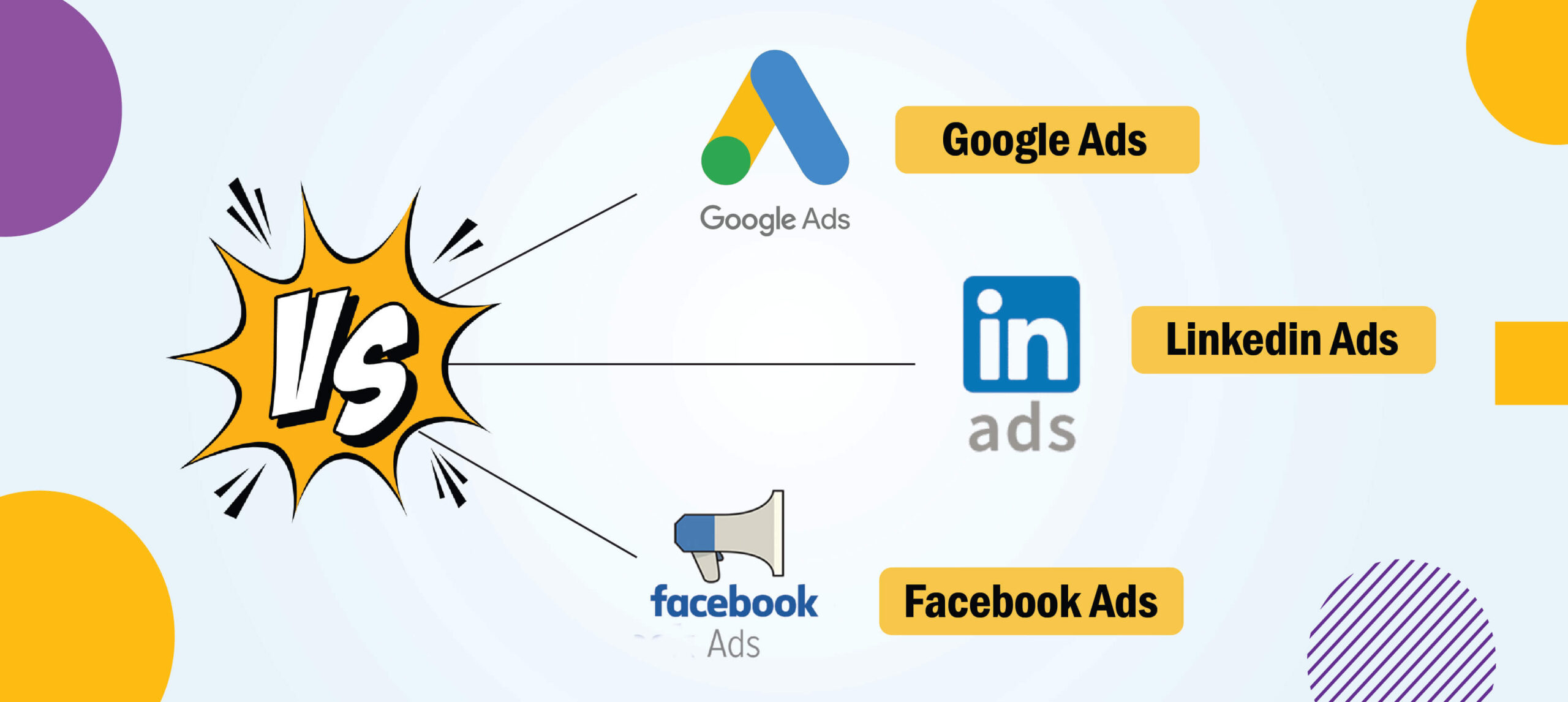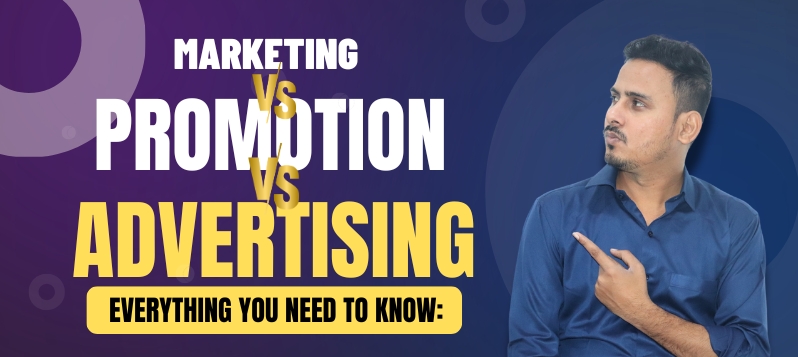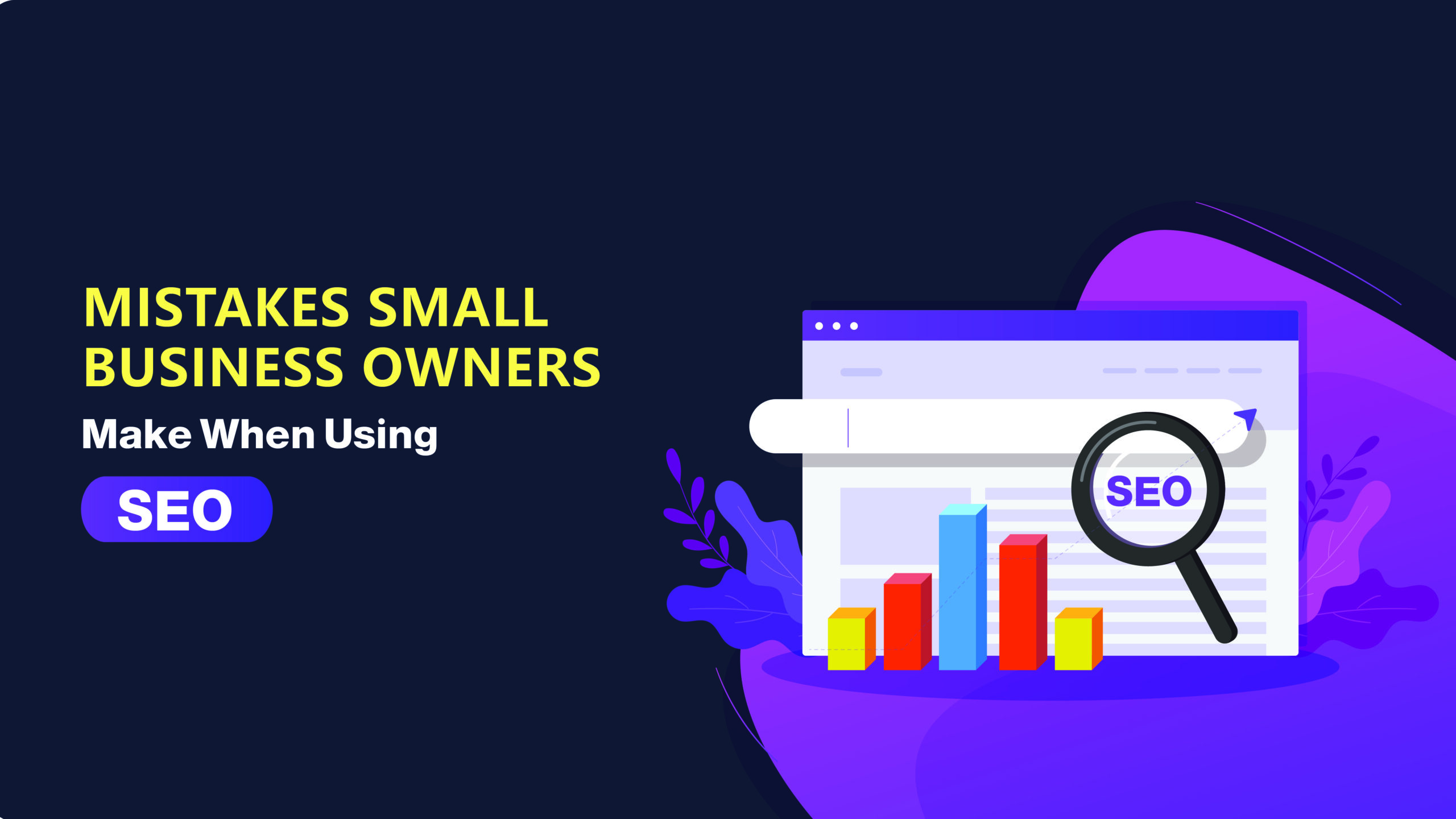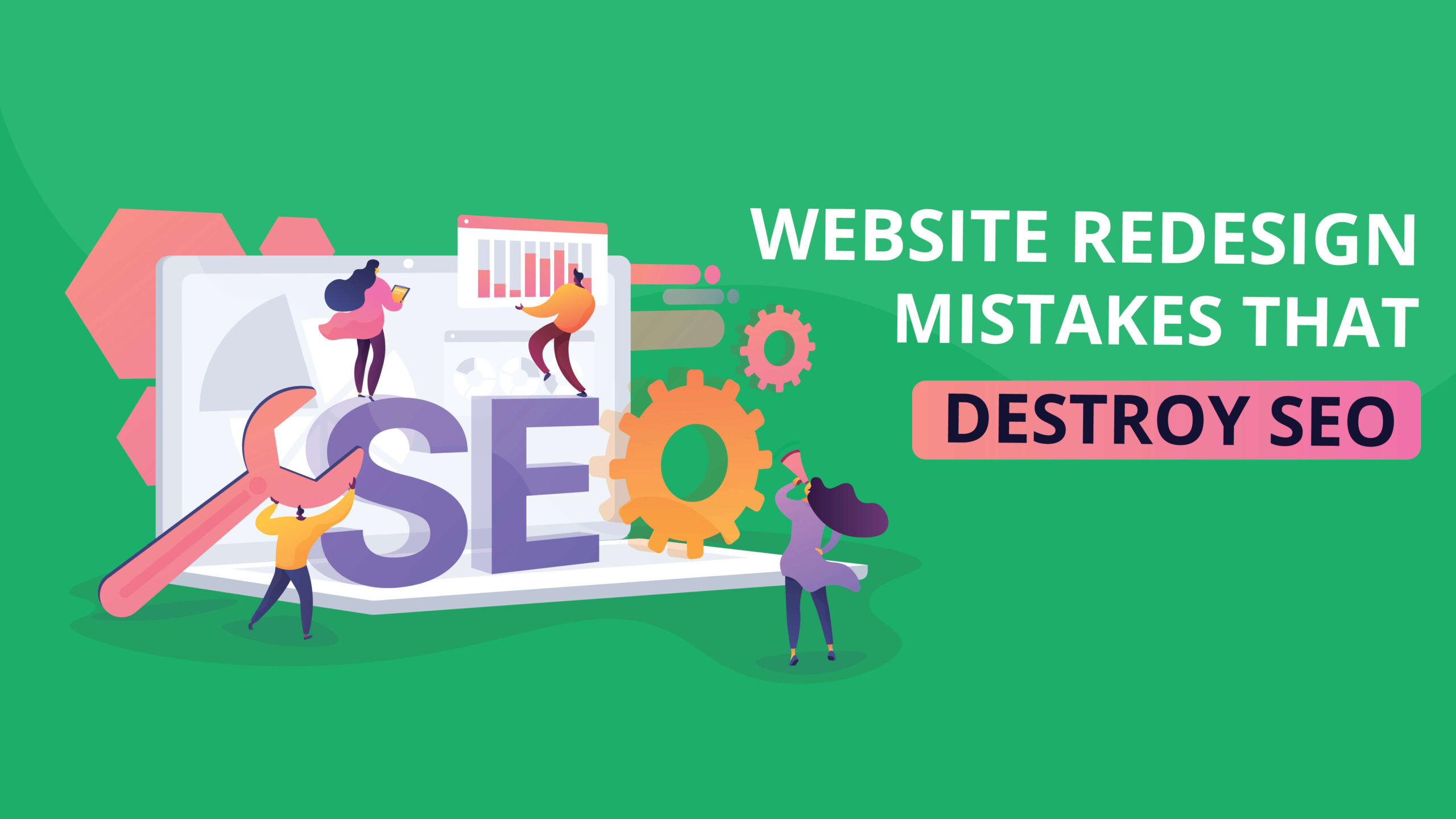Introduction
In this rapidly growing era of business, establishing a robust online presence is very much essential for your business sustained growth. For that reason Digital marketing strategies have come to act as a cornerstone for businesses aiming to navigate and create an online presence.
Among all the effective digital marketing tools available, Pay-Per-Click (PPC) advertising is one of a powerful and efficient means to drive targeted traffic and achieve positive results.
Also Read: Pinterest Ads Vs Facebook Ads
Importance of Digital Marketing Strategies for Business Growth
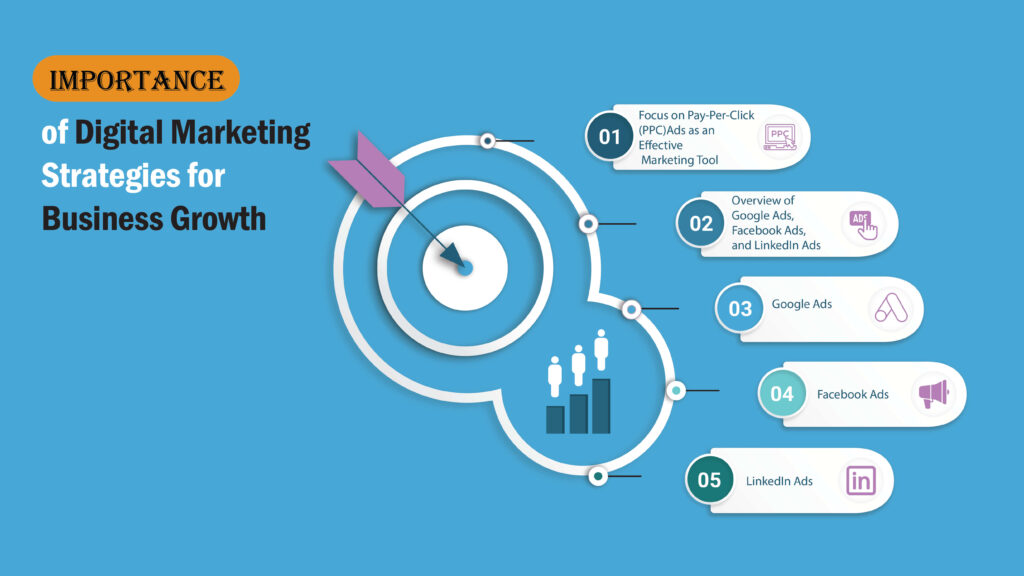
Digital marketing as you all know, has now emerged from being an option to basic necessity for all types of businesses.
In this digital marketing era where consumers are increasingly turning to online channels for more information and transactions, it is necessary to have a well-crafted digital marketing strategy for your brand visibility, customer engagement, and revenue generation.
Not only that it also helps you to compete with your effective competitors. Having a proper digital marketing strategy helps businesses to expand their reach of the internet and to effectively connect with their target audience to stay ahead in the competition.
Also Read: Why SEO Audit is Important Enhancing Your Online Success
1. Focus on Pay-Per-Click (PPC) Ads as an Effective Marketing Tool:
Among all the other digital marketing strategies, PPC ads stand out as a versatile and results-driven tool. Unlike traditional advertising models where businesses have a huge amount for ad placement, in PPC you should only have to pay when someone clicks on your ads.
This ensures a more cost-effective approach. The ability to control spending, target specific demographics, and track campaign performance in real-time makes PPC an indispensable component of a digital marketing strategy.
Also Read: Facebook Ads Active But Not Spending Trouble Shooting Guide
2. Overview of Google Ads, Facebook Ads, and LinkedIn Ads:
As you know nowadays there are numerous platforms which offer PPC advertising, But among them there are three giants that dominate the landscape: Google Ads, Facebook Ads, and LinkedIn Ads.
Each platform has a different audience base and also serves distinct purposes in the realm of digital advertising.
Also Read: Tik-Tok Ads Vs Facebook Ads
3. Google Ads:
Google, with its massive search engine user base, gives opportunities for businesses to promote their products and services. Offering a variety of ad formats, that may include text, image, video, call, and product ads, Google Ads excels in delivering extensive reach and faster results as compared to the traditional Search Engine Optimization (SEO) strategies.
Also Read: Facebook Ad Headline Vs Description
4. Facebook Ads:
It is mainly known as a social media marketing powerhouse, Facebook allows businesses to target their audience with unprecedented precision. With a range of ad formats such as photo ads, playables, slideshows, carousels, collections, and videos, Facebook Ads leverage the platform’s popularity and simplicity helps businesses to get high return on investment (ROI).
Also Read: Best Social Media Platforms for Restaurants
5. LinkedIn Ads:
Linkedin Ads is mainly tailored for the business-to-business (B2B) landscape, LinkedIn Ads helps business owners to connect with decision-makers and other key industry players.
The platform’s advanced targeting options, including location, interests, and industry, allows advertisers to reach their audience with unparalleled accuracy. Sponsored Content and Sponsored InMail further enhance the effectiveness of LinkedIn Ads for B2B firms.
As you now have got an effective overview of Google Ads, Facebook Ads, and LinkedIn Ads, You might have got an idea that each platform offers distinct advantages.
The following sections of this article will provide an in-depth analysis of these advertising giants, unraveling their strengths and guiding businesses in making informed decisions for their online marketing endeavors.
Also Read: How to Remove Twitter From Linkedin
Google Ads: Unraveling the Power of Search Engine Advertising
1. Definition and Overview of Google Ads:
Google Ads is known as a cornerstone of online advertising, it is basically a pay-per-click (PPC) platform provided by Google. It allows businesses to create and display their ads on the Google search engine and also across its extensive network. It comes with a variety of ad formats which includes text, image, video, call, and product ads, Google Ads enables advertisers to tailor their campaigns to suit diverse marketing objectives.
Also Read: Best Programmatic Advertising Platforms
2. Extensive Reach: Leveraging the Popularity of Google’s Search Engine:
The major strengths of Google Ads lies in its broader reach. Google’s search engine as you know is a go-to destination for millions of users seeking information, products, or services. By placing ads on Google, businesses can tap into this vast audience and can effectively increase their website visibility. When users actively search for solutions related to the business offerings, Google Ads provides a strategic avenue for capturing their attention and helps to drive qualified traffic to the advertiser’s website.
Also Read: Google Shopping Ads Vs Search Ads
3. Faster Results Compared to SEO: Instant Visibility and Traffic:
Google Ads is not like Search Engine Optimization (SEO), which requires time to build organic visibility, it delivers almost instantaneous results. As soon as a campaign gets activated, ads start to appear on the SERPs, ensuring immediate visibility to potential customers. This rapid deployment is particularly an advantage for businesses aiming to achieve quick wins, launch new products, or capitalize on timely opportunities. The speed of Google Ads helps in long-term SEO efforts, providing businesses with a well-rounded digital marketing strategy.
Also Read: Website Redesign Mistakes Destroying SEO
4. Optimizing ROI with Various Bidding Strategies:
Maximizing return on investment (ROI) is one of the crucial factors of any advertising campaign, As Google Ads provides a range of bidding strategies to achieve their goal.
Advertisers have various bidding options, such as cost-per-click (CPC), cost-per-thousand-impressions (CPM), and cost-per-acquisition (CPA).
Each strategy caters to a specific market, allowing businesses to set their bids accordingly. This flexibility empowers advertisers to fine-tune their campaigns, ensuring optimal performance within their budget constraints.
Also Read: How Often Should you Evaluate Your Paid Media Budget
5. In-depth Analysis of Advantages and Strengths:
Google Ads has got several advantages that can effectively contribute to its efficacy as a digital advertising platform. The ability to target users actively searching for relevant products or services increases the chance of getting conversions.
The platform’s accurate analytics and detailed reporting tools provide valuable insights into campaign performance, enabling data-driven decision-making. Not only that, Google Ads supports a diverse range of ad formats which indirectly allows advertisers to choose the most suitable option for their goals.
Also Read: Targeting Small Business Owners in Facebook
Facebook Ads: Targeting the Masses with Precision
1. Definition and Overview of Facebook Ads:
Facebook Ads as you know is a robust advertising platform offered by the social media giant, Facebook. It allows businesses to create and display ads within the Facebook ecosystem, reaching a vast user base.
Facebook Ads has a variety of ad formats, including photo ads, video ads, slideshows, and carousels. Facebook Ads provides a dynamic and visually engaging avenue for advertisers.
2. Targeting Capabilities: Granularity Level and Precision Targeting:
One of the unique features of Facebook Ads is its unparalleled targeting capabilities. Advertisers can set their audience according to the granularity level that goes beyond demographics. Factors such as interests, behaviors, location, and even connections allow for a set and precious targeting.
This level of specificity ensures that ads are reaching those peoples who find them relevant, indirectly increasing the chances of engagement and conversion.
3. Creating Ads for Specific Goals: Engagement, Website Clicks, Page Likes, etc:
Facebook Ads has a user-friendly interface that simplifies the ad creation process. Advertisers can easily choose from the range of predefined goals, such as increasing the user engagement on the website, driving website clicks, acquiring more page likes.
This flexibility empowers businesses to perfectly blend with their ads with specific objectives, tailoring campaigns to achieve the desired outcomes. The platform’s versatility accommodates diverse marketing goals, making it a versatile tool for advertisers.
4. Leveraging the Widespread Use of Social Media:
With billions of active users, Facebook is one of the most widely used social media platform around the globe. This popularity presents a significant advantage for businesses leveraging Facebook Ads.
Users spend an ample amount of time on this platform, businesses can strategically position their ads to capture their attention, Create brand awareness, and drive user engagement to get an effective lead.
Advertising on a platform where users seamlessly share their personal information and preferences enhances creating highly targeted and relevant campaigns.
5. Analysis of Advantages and Strengths:
Facebook Ads, often considered as a heart of social media advertising, boasts several advantages that set it apart in the digital advertising landscape.
The platform’s effective targeting capabilities, offers user-friendly ad creation process, making it one of the most preferred choices for all types of businesses.
The ability to choose specific goals, whether it’s a website engagement, website clicks, or page likes, will help advertisers to tailor campaigns as per their unique objectives.
Moreover, the widespread use of social media ensures that businesses can connect with a wide range of diverse audiences. The visual appeal of Facebook Ads, combined with the platform’s unique features generate higher user engagement.
Not only that, the platform’s robust analytics tools effectively help the advertisers to measure their campaign performance and help them to refine the strategy for optimal results.
As we explore the strengths of Facebook Ads, it becomes evident that its capabilities complement the dynamics of Google Ads. Well further we will unravel the unique advantages of LinkedIn Ads, particularly tailored for the business-to-business (B2B) landscape, and also provide you with the insights into how it differentiates itself in the world of digital advertising.
LinkedIn Ads: Navigating the B2B Landscape
1. Definition and Overview of LinkedIn Ads:
LinkedIn Ads is one of the powerful. paid advertising platform tailored for professional networking. It is mainly designed to cater specifically to the business-to-business (B2B) landscape, LinkedIn Ads provides a unique avenue for businesses to connect with decision-makers, industry professionals, and key audience members within the LinkedIn community.
2. Accurate Audience Targeting: Advanced Options for Precision:
LinkedIn Ads distinguishes itself from other social media platforms by providing advanced targeting options, which allows advertisers to reach their targeted audience with exceptional precision.
As Sujit Shukla emphasis advertisers can target their users based on various criteria such as location, job title, industry, company size, and even specific skills. This targeting option helps businesses to tailor their campaigns to a niche audience, ensuring that their message reaches only to their intended and targeted audience.
3. Directly Reaching the Target Audience through Sponsored InMail:
One of the unique features of LinkedIn Ads is the ability to directly engage with the target audience through direct sponsored mail. This personalized messaging system allows advertisers unique effective and customized messages directly to the users Linkedin inbox.
By leveraging Sponsored InMail, businesses can deliver content such as invitations, or promotional offers directly to their potential clients, fostering a direct connection.
4. Enhancing Account-Based Marketing (ABM) Efforts:
LinkedIn Ads gets easily integrated with Account-Based Marketing (ABM) strategies, to target their specific audience. The platform’s unique targeting options easily align with the principles of ABM, enabling businesses to create campaigns directed at key accounts.
This feature is not that effective for B2B companies who are looking to build relationships with specific organizations or decision-makers.
5. Examining Advantages and Strengths:
LinkedIn Ads comes with several distinctive advantages, which makes it an indispensable tool for businesses operating in the B2B space. The advanced targeting options ensure that ads are presented to unique and their highly qualified audience, increasing the likelihood of engagement and conversions.
The direct communication facilitated by Sponsored InMail helps you to build more personal connections with your clients, enhancing the effectiveness of outreach efforts.
Moreover, LinkedIn Ads’ compatibility with Account-Based Marketing enhances its appeal for businesses with specific target accounts. The platform’s professional environment, where users provide accurate and up-to-date information, further contributes to the precision and effectiveness of LinkedIn Ads.
Comparative Analysis: Google Ads vs Facebook Ads vs LinkedIn Ads
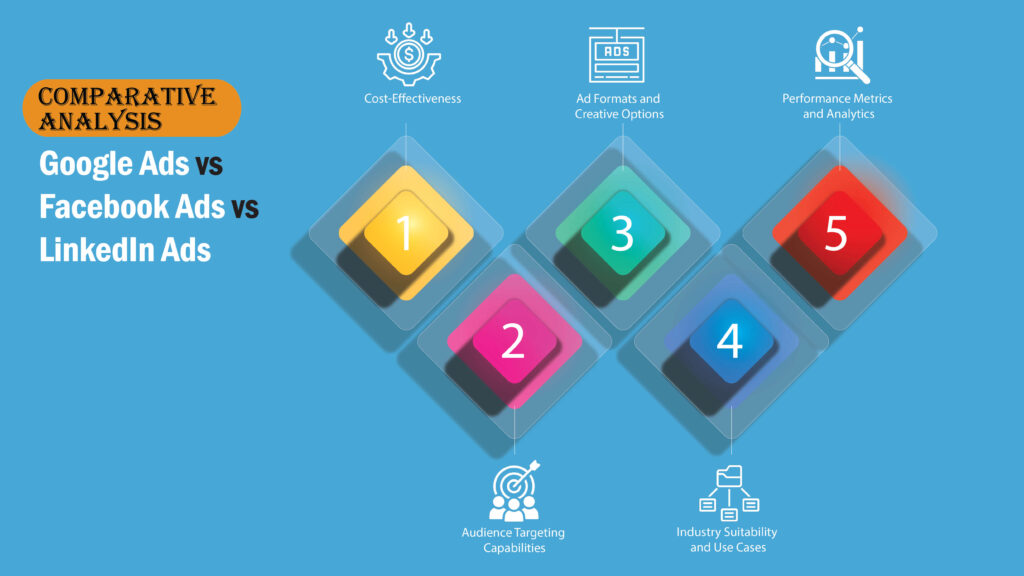
In this competitive era of digital advertising, businesses often face challenges like choosing the most suitable platform to achieve their business goals. But don’t worry, we have brought you a comparative analysis of Google Ads, Facebook Ads, and LinkedIn Ads across various dimensions that provides detailed insights for businesses seeking a comprehensive understanding of each platform’s strengths and capabilities.
A. Cost-Effectiveness:
Google Ads:
- Pros: Google Ads operates as a PPC model, ensuring that advertisers only pay when any users click on their ads. This cost-effective approach allows businesses to control their spending and to diversify their budget to various other business needs.
- Cons: But alway remember Competition for keywords can lead to increased bid prices, potentially impacting overall campaign costs.
Facebook Ads:
- Pros: Facebook Ads often provides you a cost effective solution, especially for businesses looking to reach a wide audience with visually engaging content. The platform’s bidding system allows advertisers to set a particular budget based on their financial constraints.
- Cons: Costs may slightly vary based on their audience targeting and the competitiveness of the advertising space.
LinkedIn Ads:
- Pros: While LinkedIn Ads tend to have a higher cost per click (CPC), they can be really cost-effective for businesses targeting professionals and B2B audiences. The platform’s precision targeting justifies the investment for businesses seeking quality leads.
- Cons: Higher CPC may not be always suitable for businesses who has limited budgets.
B. Audience Targeting Capabilities:
Google Ads:
- Pros: Google Ads is a pro factor in keyword-based targeting, allowing advertisers to reach users actively searching for specific products or services using specific keywords. It also offers location-based targeting and demographic targeting to refine audience reach.
- Cons: While effective, audience targeting on Google Ads may not be as granular as on social media platforms.
Facebook Ads:
- Pros: Facebook Ads stand has got highly advanced audience targeting capabilities. Advertisers can easily target users based on demographics, interests, behaviors, and even connections, ensuring precise audience reach.
- Cons: While powerful, excessive granularity may lead to smaller audience sizes.
LinkedIn Ads:
- Pros: LinkedIn Ads specialize in targeting professionals based on their job title, industry, company size, and more. This granularity is ideal for B2B businesses seeking to connect with decision-makers.
- Cons: The professional nature of LinkedIn’s audience may limit the platform’s effectiveness for certain consumer-focused products.
C. Ad Formats and Creative Options:
Google Ads:
- Pros: Google Ads has got a wide range of ad formats including text, image, video, call, and product ads. This flexibility allows advertisers to choose formats that align with their marketing objectives.
- Cons: Display options may be limited compared to visually rich platforms.
Facebook Ads:
- Pros: Facebook Ads offer a variety of visually engaging content formats, such as photo ads, playables, slideshows, carousels, collections, and videos. This diversity allows creative campaigns.
- Cons: Ad fatigue may occur if creative contents are not refreshed regularly.
LinkedIn Ads:
- Pros: LinkedIn Ads support text ads, Sponsored Content, and Sponsored InMail. It is more professional-oriented, the platform provides opportunities for impactful B2B advertising.
- Cons: Visual options may be more limited as compared to other social media platforms.
D. Industry Suitability and Use Cases
Google Ads:
- Suitability: it is Ideal for businesses across various industries, especially those offering products or services with active search demand.
- Use Cases:Google ads is well suited for e-commerce, service-oriented businesses, and local businesses to get an immediate and positive result.
Facebook Ads:
- Suitability:it is suitable for businesses who have a diverse industry, particularly those with visually appealing products or those aiming to build brand awareness.
- Use Cases: Effective for e-commerce, brand-building, lead generation, and campaigns focused on user engagement.
LinkedIn Ads:
- Suitability:Linkedin is Tailored for B2B businesses and industries where professional networking and decision-maker targeting are crucial.
- Use Cases: It is ideal for industries such as technology, finance, consulting, and other sectors where precise targeting of professionals is essential.
E. Performance Metrics and Analytics
Google Ads:
- Metrics: The Key metrics on Google ads include click-through rate (CTR), conversion rate, quality score, and impression share.
- Analytics: Robust analytics tools give you detailed insights into campaign performance, allowing for data-driven optimizations.
Facebook Ads:
- Metrics: Key metrics include engagement rate, click-through rate (CTR), conversion rate, and relevance score.
- Analytics: Facebook’s analytics tools also provide detailed performance data, including demographic insights and ad engagement metrics.
LinkedIn Ads:
- Metrics: Key metrics include click-through rate (CTR), engagement rate, conversion rate, and social actions.
- Analytics: LinkedIn Ads provide an analytics tool which mainly focuses on professional demographics, allowing insights of audience engagement and lead quality.
Choosing the Right Platform for Your Business
As Sujit Shukla states In this 21st era of digital advertising, selecting the most suitable platform for your business is a crucial decision that can significantly impact your marketing success. To make a correct choice, businesses need to consider various factors ranging from business type and goals to budget constraints and target audience dynamics.
A. Considering Business Type and Goals
Google Ads:
- Ideal for: Businesses with products or services that fulfill active search intent.
- Goals: Google Ads is Well-suited for businesses aiming for immediate visibility, lead generation, and capturing users for more engagement.
Facebook Ads:
- Ideal for: Businesses across diverse industries, especially those who are looking to give their audience a visually appealing product view or for those who are prioritizing brand awareness.
- Goals: Effective for building brand presence, engaging with users, and running campaigns focused on user interaction and social engagement.
LinkedIn Ads:
- Ideal for: B2B businesses help in targeting professionals and decision-makers.
- Goals: Tailored for lead generation, building industry connections, and enhancing brand recognition within the professional sphere.
B. Evaluating Budget Constraints:
Google Ads:
- Budgeting: Google ads Offers flexibility with a pay-per-click model and also controls businesses over spending.
- Consideration: Google ads is Ideal for businesses with varying budgets looking for a scalable and measurable approach.
Facebook Ads:
- Budgeting: Provides helps the advertisers to set a budget based on their financial constraints.
- Consideration: Facebook ads is mainly Suitable for businesses looking for cost-effective solutions with visually engaging content.
LinkedIn Ads:
- Budgeting: May have a higher cost per click (CPC), making it more suitable for businesses with a dedicated B2B focus and a higher budget.
- Consideration: Appropriate for businesses willing to invest in precise targeting and quality lead generation.
C. Analyzing the Competitive Landscape
Google Ads:
- Competition: There is a High competition for popular keywords that may impact bid prices.
- Consideration: It is Ideal for businesses with a strategic approach to keyword targeting and an understanding of their competitive landscape.
Facebook Ads:
- Competition: While competition exists, the platform offers a broad audience base, allowing for diverse targeting strategies.
- Consideration: Effective for businesses in competitive industries seeking unique ways to engage with their audience.
LinkedIn Ads:
- Competition: Niche targeting may result in lower competition within specific professional demographics.
- Consideration: Suitable for B2B businesses looking to capitalize on a focused and less saturated advertising space.
D. Aligning with the Target Audience:
Google Ads:
- Audience: Targets users actively searching for specific products or services.
- Consideration: Ideal for businesses with a broad or niche audience actively using search engines.
Facebook Ads:
- Audience: Highly versatile targeting, reaching users based on demographics, interests, and behaviors.
- Consideration: Suitable for businesses with a diverse audience interested in visually engaging content.
LinkedIn Ads:
- Audience: Targets professionals and decision-makers based on job titles, industries, and company size.
- Consideration: Perfect for B2B businesses aiming to connect with a specific professional audience.
E. Strategic Combination of Platforms for Holistic Marketing
Holistic Approach:
- Strategic Combination: Consider combining Google Ads, Facebook Ads, and LinkedIn Ads for a comprehensive and diversified digital marketing strategy.
- Benefits: Leverage the strengths of each platform to reach different segments of your target audience and achieve various marketing objectives.
Campaign Integration:
- Synergy: Ensure synergy between campaigns on different platforms to maintain a cohesive brand image and messaging.
- Cross-Platform Insights: Utilize cross-platform analytics to understand how each channel contributes to the overall marketing performance.
Conclusion
In the journey through the realms of digital advertising, we’ve explored the distinct features and strengths of three powerful platforms—Google Ads, Facebook Ads, and LinkedIn Ads. Each platform brings unique capabilities to the table, catering to diverse business needs and marketing objectives.
- Google Ads: Unleashing the power of search engine advertising, Google Ads offers extensive reach, faster results than SEO, and a variety of bidding strategies. Ideal for businesses aiming to capture immediate search intent, Google Ads stands as a formidable force in the online advertising landscape.
- Facebook Ads: Targeting the masses with precision, Facebook Ads excels in its advanced audience targeting capabilities, creative options, and widespread use of social media. Suited for businesses across industries, Facebook Ads is a go-to platform for those seeking visually engaging content and brand-building opportunities.
- LinkedIn Ads: Navigating the B2B landscape, LinkedIn Ads stands out with its accurate audience targeting, direct outreach through Sponsored InMail, and enhancement of Account-Based Marketing (ABM) efforts. Tailored for professionals and decision-makers, LinkedIn Ads is the preferred choice for businesses in the B2B sector.
Choosing the right platform for your business requires a thoughtful consideration of your unique goals, target audience, and budget constraints. For businesses seeking immediate visibility and catering to active search intent, Google Ads is a strategic choice. If your aim is to build brand awareness and engage with a diverse audience through visually appealing content, Facebook Ads is a powerful ally. Meanwhile, for B2B businesses looking to connect with professionals and decision-makers, LinkedIn Ads emerges as a tailored solution.

